| Listing 1 - 10 of 70 | << page >> |
Sort by
|
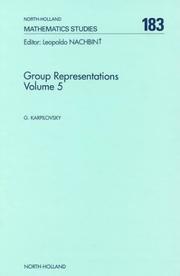
ISBN: 1283525216 9786613837660 0080872867 044488632X Year: 1992 Publisher: Amsterdam : North-Holland,
Abstract | Keywords | Export | Availability | Bookmark
 Loading...
Loading...Choose an application
- Reference Manager
- EndNote
- RefWorks (Direct export to RefWorks)
Part A: Background Material and Part B: Introduction to Group Representations and Characters
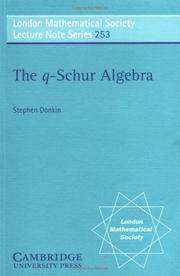
ISBN: 1139885480 1107367646 1107372208 1107362733 1107369274 1299405266 110736518X 0511893515 0511600704 9781107362734 9780511893513 9780521645584 0521645581 9780511600708 Year: 1998 Publisher: Cambridge, U.K. ; New York : Cambridge University Press,
Abstract | Keywords | Export | Availability | Bookmark
 Loading...
Loading...Choose an application
- Reference Manager
- EndNote
- RefWorks (Direct export to RefWorks)
This book focuses on the representation theory of q-Schur algebras and connections with the representation theory of Hecke algebras and quantum general linear groups. The aim is to present, from a unified point of view, quantum analogues of certain results known already in the classical case. The approach is largely homological, based on Kempf's vanishing theorem for quantum groups and the quasi-hereditary structure of the q-Schur algebras. Beginning with an introductory chapter dealing with the relationship between the ordinary general linear groups and their quantum analogies, the text goes on to discuss the Schur Functor and the 0-Schur algebra. The next chapter considers Steinberg's tensor product and infinitesimal theory. Later sections of the book discuss tilting modules; the Ringel dual of the q-Schur algebra; Specht modules for Hecke algebras; and the global dimension of the q-Schur algebras. An appendix gives a self-contained account of the theory of quasi-hereditary algebras and their associated tilting modules. This volume will be primarily of interest to researchers in algebra and related topics in pure mathematics.
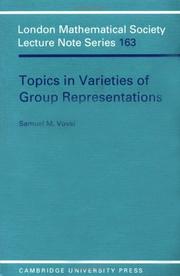
ISBN: 1139884751 1107366704 1107371384 1107361796 1107369045 1299404456 1107364248 0511525966 9781107361799 9780511525964 9780521424103 0521424100 0521424100 Year: 1991 Publisher: Cambridge ; New York : Cambridge University Press,
Abstract | Keywords | Export | Availability | Bookmark
 Loading...
Loading...Choose an application
- Reference Manager
- EndNote
- RefWorks (Direct export to RefWorks)
This book is devoted to the theory of group representations, a young and promising area of modern algebra. It provides a detailed exposition of several central topics in the field, leading to the most current advances and developments. Much of the included material has never been available in book form before. It is intended for a broad audience of researchers and graduate students, working in abstract algebra and its many applications.
Book
ISBN: 9812793410 9789812793416 9812793402 9789812793409 Year: 2008 Publisher: Singapore Hackensack, NJ World Scientific
Abstract | Keywords | Export | Availability | Bookmark
 Loading...
Loading...Choose an application
- Reference Manager
- EndNote
- RefWorks (Direct export to RefWorks)
This book is a festschrift in honor of Professor Anthony Gaglione's sixtieth birthday. This volume presents an excellent mix of research and expository articles on various aspects of infinite group theory. The papers give a broad overview of present research in infinite group theory in general, and combinatorial group theory and non-Abelian group-based cryptography in particular. They also pinpoint the interactions between combinatorial group theory and mathematical logic, especially model theory.
Infinite groups. --- Representations of groups. --- Group representation (Mathematics) --- Groups, Representation theory of --- Group theory --- Groups, Infinite
Book

ISBN: 3110810387 9783110810387 Year: 2017 Publisher: Berlin Boston
Abstract | Keywords | Export | Availability | Bookmark
 Loading...
Loading...Choose an application
- Reference Manager
- EndNote
- RefWorks (Direct export to RefWorks)
Representations of groups. --- Infinite groups --- Groups, Infinite --- Group theory --- Group representation (Mathematics) --- Groups, Representation theory of

ISBN: 128216791X 9786612167911 0080872913 044487433X 9780080872919 Year: 1994 Publisher: Amsterdam : Elsevier Science,
Abstract | Keywords | Export | Availability | Bookmark
 Loading...
Loading...Choose an application
- Reference Manager
- EndNote
- RefWorks (Direct export to RefWorks)
This third volume can be roughly divided into two parts. The first part is devoted to the investigation of various properties of projective characters. Special attention is drawn to spin representations and their character tables and to various correspondences for projective characters. Among other topics, projective Schur index and projective representations of abelian groups are covered. The last topic is investigated by introducing a symplectic geometry on finite abelian groups. The second part is devoted to Clifford theory for graded algebras and its application to the corresponding theo
Representations of groups. --- Group theory. --- Groups, Theory of --- Substitutions (Mathematics) --- Algebra --- Group representation (Mathematics) --- Groups, Representation theory of --- Group theory
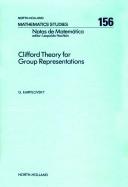
ISBN: 1281790575 9786611790578 0080872670 0444873775 9780444873774 9780080872674 9781281790576 Year: 1989 Publisher: Amsterdam ; New York : New York, N.Y., U.S.A. : North-Holland ; Sole distributors for the U.S.A. and Canada, Elsevier Science Pub. Co.,
Abstract | Keywords | Export | Availability | Bookmark
 Loading...
Loading...Choose an application
- Reference Manager
- EndNote
- RefWorks (Direct export to RefWorks)
Let N be a normal subgroup of a finite group G and let F be a field. An important method for constructing irreducible FG-modules consists of the application (perhaps repeated) of three basic operations: (i) restriction to FN. (ii) extension from FN. (iii) induction from FN. This is the `Clifford Theory' developed by Clifford in 1937. In the past twenty years, the theory has enjoyed a period of vigorous development. The foundations have been strengthened and reorganized from new points of view, especially from the viewpoint of graded rings and crossed products.The purpos
Clifford algebras. --- Representations of groups. --- Group representation (Mathematics) --- Groups, Representation theory of --- Group theory --- Geometric algebras --- Algebras, Linear
Book
ISBN: 9780521768078 0521768071 9780511750915 9781107471733 9780511750175 051175017X 9780511743627 0511743629 0511750919 1107209196 1282657887 051174255X 9786612657887 0511749430 0511744714 Year: 2010 Publisher: Cambridge ; New York : Cambridge University Press,
Abstract | Keywords | Export | Availability | Bookmark
 Loading...
Loading...Choose an application
- Reference Manager
- EndNote
- RefWorks (Direct export to RefWorks)
The representation theory of finite groups has seen rapid growth in recent years with the development of efficient algorithms and computer algebra systems. This is the first book to provide an introduction to the ordinary and modular representation theory of finite groups with special emphasis on the computational aspects of the subject. Evolving from courses taught at Aachen University, this well-paced text is ideal for graduate-level study. The authors provide over 200 exercises, both theoretical and computational, and include worked examples using the computer algebra system GAP. These make the abstract theory tangible and engage students in real hands-on work. GAP is freely available from www.gap-system.org and readers can download source code and solutions to selected exercises from the book's web page.
Representations of groups --- Data processing. --- Finite groups. --- Groups, Finite --- Group theory --- Modules (Algebra) --- Group representation (Mathematics) --- Groups, Representation theory of
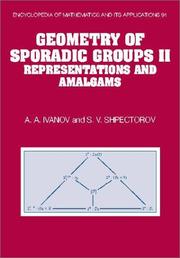
ISBN: 1139882422 0511971524 1107103371 146194144X 1107089093 1107095301 0511550243 1107092043 9781461941446 9781107089099 9780511550249 9780521623490 0521623499 9781139882422 9780511971525 9781107103375 9781107095304 9781107092044 Year: 2002 Publisher: Cambridge, U.K. : Cambridge University Press,
Abstract | Keywords | Export | Availability | Bookmark
 Loading...
Loading...Choose an application
- Reference Manager
- EndNote
- RefWorks (Direct export to RefWorks)
This is the second volume in a two-volume set, which provides a complete self-contained proof of the classification of geometries associated with sporadic simple groups: Petersen and tilde geometries. The second volume contains a study of the representations of the geometries under consideration in GF(2)-vector spaces as well as in some non-abelian groups. The central part is the classification of the amalgam of maximal parabolics, associated with a flag transitive action on a Petersen or tilde geometry. The classification is based on the method of group amalgam, the most promising tool in modern finite group theory. Via their systematic treatment of group amalgams, the authors establish a deep and important mathematical result. This book will be of great interest to researchers in finite group theory, finite geometries and algebraic combinatorics.
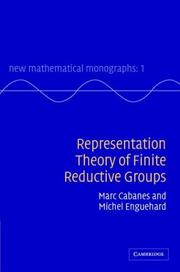
ISBN: 9780511542763 9780521825177 0511165668 9780511165665 0511163738 9780511163739 0521825172 051116453X 9780511164538 0511184131 9780511184130 0511542763 1280437413 9781280437410 1107146607 9786610437412 0511312679 Year: 2004 Publisher: Cambridge, UK ; New York : Cambridge University Press,
Abstract | Keywords | Export | Availability | Bookmark
 Loading...
Loading...Choose an application
- Reference Manager
- EndNote
- RefWorks (Direct export to RefWorks)
At the crossroads of representation theory, algebraic geometry and finite group theory, this 2004 book blends together many of the main concerns of modern algebra, with full proofs of some of the most remarkable achievements in the area. Cabanes and Enguehard follow three main themes: first, applications of étale cohomology, leading to the proof of the recent Bonnafé-Rouquier theorems. The second is a straightforward and simplified account of the Dipper-James theorems relating irreducible characters and modular representations. The final theme is local representation theory. One of the main results here is the authors' version of Fong-Srinivasan theorems. Throughout the text is illustrated by many examples and background is provided by several introductory chapters on basic results and appendices on algebraic geometry and derived categories. The result is an essential introduction for graduate students and reference for all algebraists.
Finite groups. --- Representations of groups. --- Group representation (Mathematics) --- Groups, Representation theory of --- Group theory --- Groups, Finite --- Modules (Algebra)
| Listing 1 - 10 of 70 | << page >> |
Sort by
|

 Search
Search Feedback
Feedback About UniCat
About UniCat  Help
Help News
News